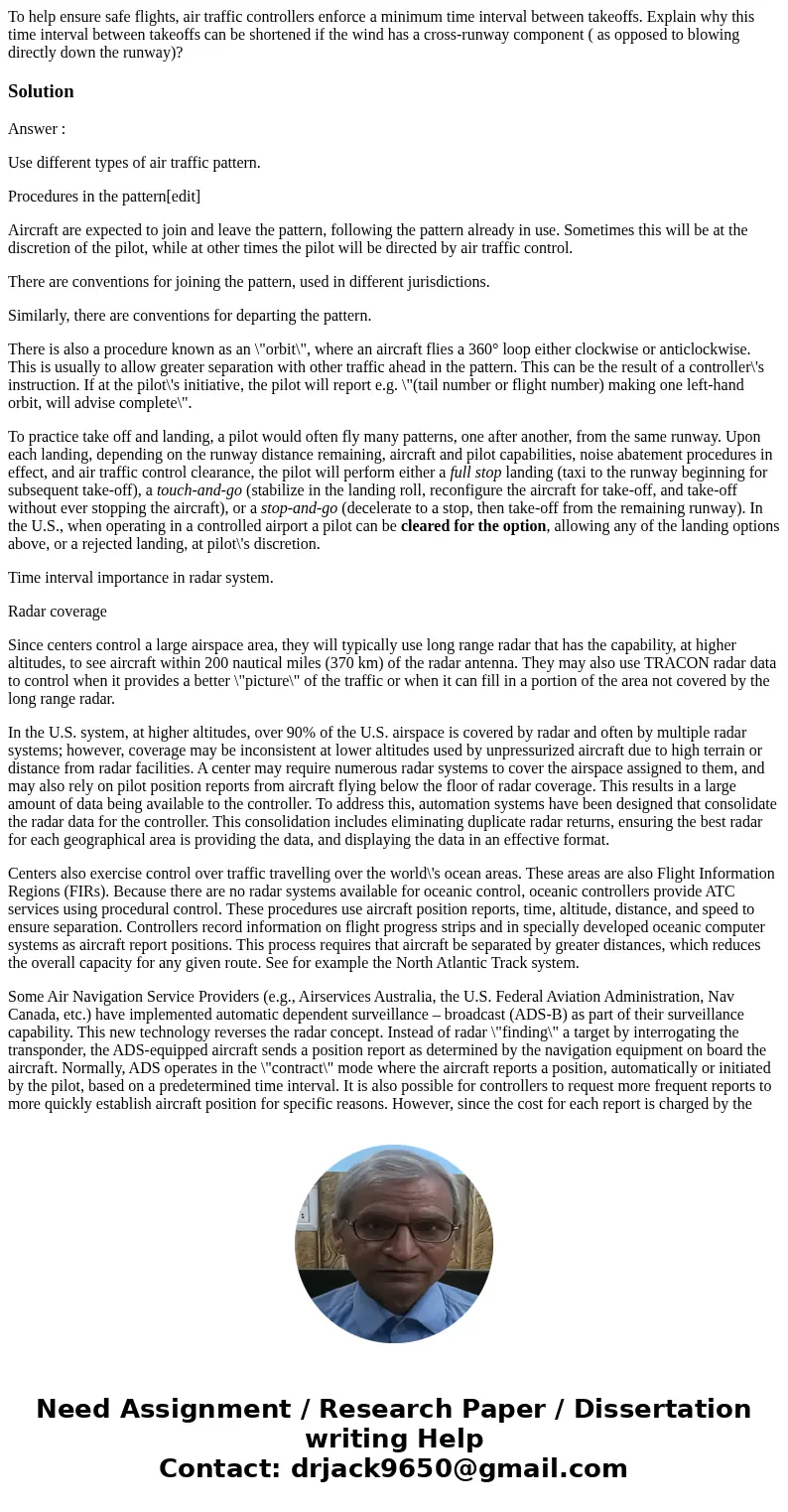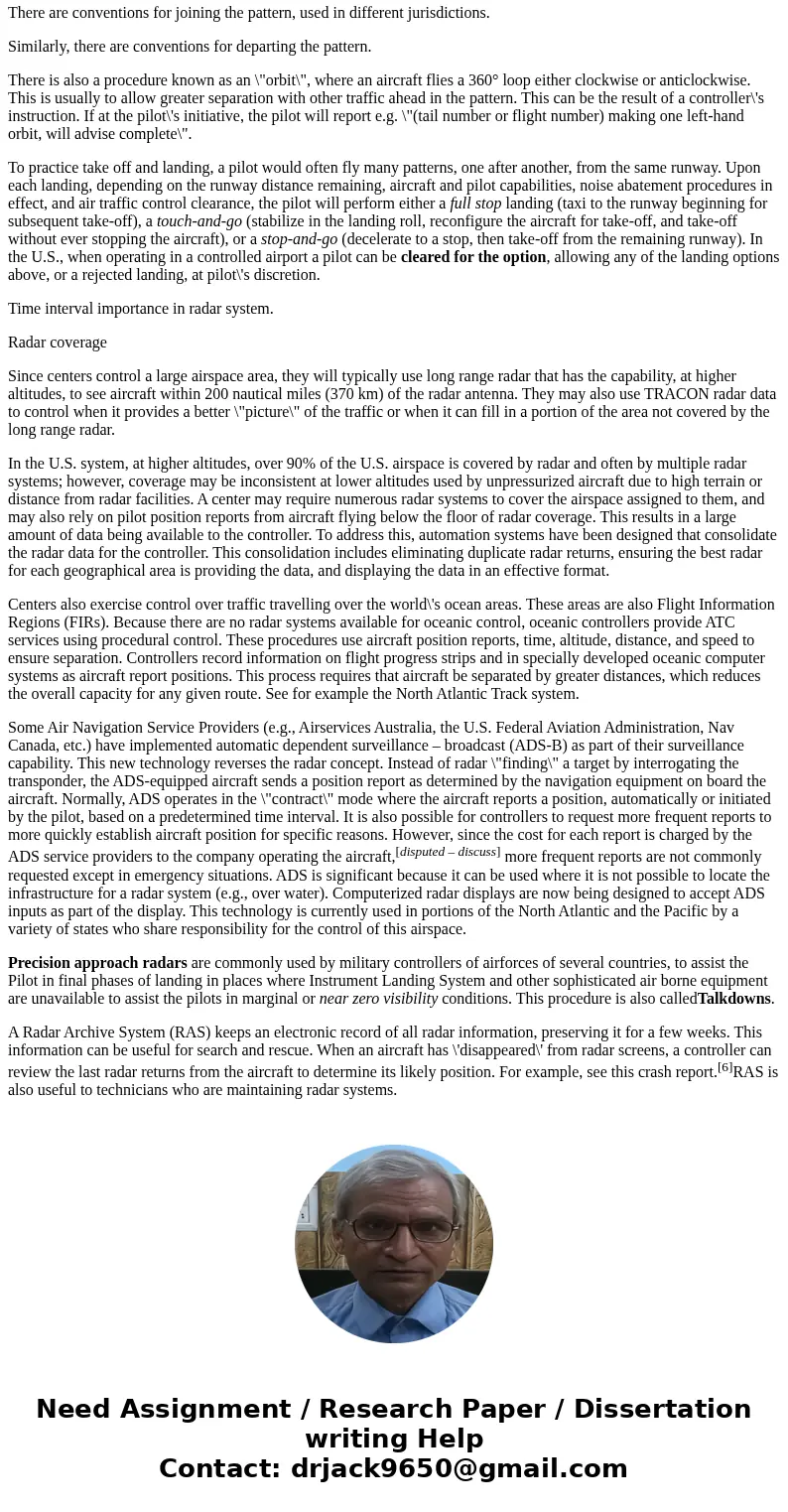To help ensure safe flights air traffic controllers enforce
To help ensure safe flights, air traffic controllers enforce a minimum time interval between takeoffs. Explain why this time interval between takeoffs can be shortened if the wind has a cross-runway component ( as opposed to blowing directly down the runway)?
Solution
Answer :
Use different types of air traffic pattern.
Procedures in the pattern[edit]
Aircraft are expected to join and leave the pattern, following the pattern already in use. Sometimes this will be at the discretion of the pilot, while at other times the pilot will be directed by air traffic control.
There are conventions for joining the pattern, used in different jurisdictions.
Similarly, there are conventions for departing the pattern.
There is also a procedure known as an \"orbit\", where an aircraft flies a 360° loop either clockwise or anticlockwise. This is usually to allow greater separation with other traffic ahead in the pattern. This can be the result of a controller\'s instruction. If at the pilot\'s initiative, the pilot will report e.g. \"(tail number or flight number) making one left-hand orbit, will advise complete\".
To practice take off and landing, a pilot would often fly many patterns, one after another, from the same runway. Upon each landing, depending on the runway distance remaining, aircraft and pilot capabilities, noise abatement procedures in effect, and air traffic control clearance, the pilot will perform either a full stop landing (taxi to the runway beginning for subsequent take-off), a touch-and-go (stabilize in the landing roll, reconfigure the aircraft for take-off, and take-off without ever stopping the aircraft), or a stop-and-go (decelerate to a stop, then take-off from the remaining runway). In the U.S., when operating in a controlled airport a pilot can be cleared for the option, allowing any of the landing options above, or a rejected landing, at pilot\'s discretion.
Time interval importance in radar system.
Radar coverage
Since centers control a large airspace area, they will typically use long range radar that has the capability, at higher altitudes, to see aircraft within 200 nautical miles (370 km) of the radar antenna. They may also use TRACON radar data to control when it provides a better \"picture\" of the traffic or when it can fill in a portion of the area not covered by the long range radar.
In the U.S. system, at higher altitudes, over 90% of the U.S. airspace is covered by radar and often by multiple radar systems; however, coverage may be inconsistent at lower altitudes used by unpressurized aircraft due to high terrain or distance from radar facilities. A center may require numerous radar systems to cover the airspace assigned to them, and may also rely on pilot position reports from aircraft flying below the floor of radar coverage. This results in a large amount of data being available to the controller. To address this, automation systems have been designed that consolidate the radar data for the controller. This consolidation includes eliminating duplicate radar returns, ensuring the best radar for each geographical area is providing the data, and displaying the data in an effective format.
Centers also exercise control over traffic travelling over the world\'s ocean areas. These areas are also Flight Information Regions (FIRs). Because there are no radar systems available for oceanic control, oceanic controllers provide ATC services using procedural control. These procedures use aircraft position reports, time, altitude, distance, and speed to ensure separation. Controllers record information on flight progress strips and in specially developed oceanic computer systems as aircraft report positions. This process requires that aircraft be separated by greater distances, which reduces the overall capacity for any given route. See for example the North Atlantic Track system.
Some Air Navigation Service Providers (e.g., Airservices Australia, the U.S. Federal Aviation Administration, Nav Canada, etc.) have implemented automatic dependent surveillance – broadcast (ADS-B) as part of their surveillance capability. This new technology reverses the radar concept. Instead of radar \"finding\" a target by interrogating the transponder, the ADS-equipped aircraft sends a position report as determined by the navigation equipment on board the aircraft. Normally, ADS operates in the \"contract\" mode where the aircraft reports a position, automatically or initiated by the pilot, based on a predetermined time interval. It is also possible for controllers to request more frequent reports to more quickly establish aircraft position for specific reasons. However, since the cost for each report is charged by the ADS service providers to the company operating the aircraft,[disputed – discuss] more frequent reports are not commonly requested except in emergency situations. ADS is significant because it can be used where it is not possible to locate the infrastructure for a radar system (e.g., over water). Computerized radar displays are now being designed to accept ADS inputs as part of the display. This technology is currently used in portions of the North Atlantic and the Pacific by a variety of states who share responsibility for the control of this airspace.
Precision approach radars are commonly used by military controllers of airforces of several countries, to assist the Pilot in final phases of landing in places where Instrument Landing System and other sophisticated air borne equipment are unavailable to assist the pilots in marginal or near zero visibility conditions. This procedure is also calledTalkdowns.
A Radar Archive System (RAS) keeps an electronic record of all radar information, preserving it for a few weeks. This information can be useful for search and rescue. When an aircraft has \'disappeared\' from radar screens, a controller can review the last radar returns from the aircraft to determine its likely position. For example, see this crash report.[6]RAS is also useful to technicians who are maintaining radar systems.


 Homework Sourse
Homework Sourse